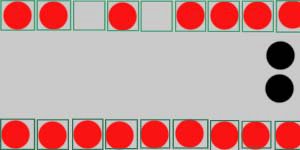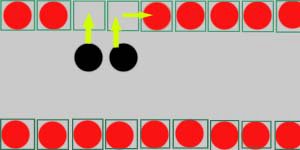"The Reflection Check-Out"
It's late. You're riding home on the T after a long laborious day at work. Suddenly, out of the monotony of the trip, a beautiful face walks through the doors into the train. Wow. She or He is pretty attractive. You want to take a longer look at them, just to size them up. Or, maybe a completely different type of person enters the T: a crazy lady with a glass eye, a psycho who's talking to himself, or perhaps even the occasional white-collar type with a bad toupee. Whether its the first scenario or the second, the fact is that you want to make a long examination of that person's face or body.
You have three options. First, you could do the "Awkward Stare". This technique is for only the most shameless of human beings. As the name suggests, this method entails looking directly at the target person for as long as the observer desires. Although the most effective method in theory, this method creates the largest residual "sketch-out" factor. The target will often look away, walk to a different part of the train, ask you to stop, or in some extreme cases grab your head by the hair and slam your face against the wall repeatedly until you scream for mercy. That only happened to me once, I swear.
Your second option is the "Stealth Stare." This method, although yielding less satisfaction, is more socially acceptable. You'll pretend to be looking at your book or shoelaces, but at key moments you'll yawn, take out your cell phone, look at your watch, etc. As you're doing this, you'll "accidentally" pass your eyes over the target person, getting a quick glimpse at their beauty/abnormality.
The third option is perhaps the most ingenious. It's also the most dangerous. I dub this third method "The Reflection Check-Out." As a warning, this method is for only the most experienced riders; novices need not attempt. Instead of looking directly at the person, you use the darkened T window as a reflector. In doing so, it appears as if you are innocently looking out the window at the dirty concrete that is passing by. In theory, you can stare as long and as much as you want with any residual "sketch-out". The only downfall of this is that the quality of the reflected image is quite poor in comparison to the "Awkward Stare." As I said before, though, this method is not without peril.
As with any reflection, whatever you can see in the reflection can see you in return. In other words, if you're looking at someone reflected in the window, they could see you back if they happened to look at the window too. This phenomenon is illustrated in figure 1.
 This is the worst way to be caught looking at someone. Therefore, the reflection check-out can yield possibly the greatest results but with the greatest risk involved. If you did ever get caught doing this, you'll probably get a dirtier look than the one that the smarmy Newbury Comics employee gave you that time you had to buy an Ashlee Simpson CD "as a gift". All you can do is avert your gaze and pretend that the whole thing never happened.
This is the worst way to be caught looking at someone. Therefore, the reflection check-out can yield possibly the greatest results but with the greatest risk involved. If you did ever get caught doing this, you'll probably get a dirtier look than the one that the smarmy Newbury Comics employee gave you that time you had to buy an Ashlee Simpson CD "as a gift". All you can do is avert your gaze and pretend that the whole thing never happened.As with anything in life, you must use discretion when undertaking any of these three techniques. As my Mom always said, "It's not polite to stare." But then again, my Mom never rode on the T.





